The George Washington class submarines, developed by General Dynamics Electric Boat Division, were the first U.S. submarines equipped with ballistic missiles.
The initial boat, USS George Washington (SSBN 589), was under construction as an attack submarine (Scorpion SSN 589). However with progress in the Army/Navy Jupiter program, especially the development of the Polaris missile, a strategic decision was made to convert Scorpion into a missile-carrying submarine. Thus, under the Bureau of Ships (BuShips) direction, the Scorpion was repurposed, marking the birth of the George Washington Class.
| George Washington class SPECIFICATIONS | |
|---|---|
| Length: | 381 ft 8 in (116.36 m) |
| Height: | 26 ft 8 in (8.13 m) |
| Width: | 33 f (10.06 m) |
| Weight: | 5,900 tons surfaced 6,700 tons submerged |
| Armament: | 16 steam ejection tubes for Polaris missiles. Six, 533-mm, torpedo tubes in the bow. |
| Speed: | 16.5 knots on the surface 22 knots submerged |
| Powerplant: | Single S5W pressurized water nuclear reactor |
| Crew complement: | 136 men; 12 officers, 124 enlisted |
| Contractors: | General Dynamics Electric Boat Division, Mare I NSYd, Newport News, Portsmouth NSYd |
| Names of submarines: | (598) George Washington, (599) Patrick Henry, (600) Theodore Roosevelt, (601) Robert E. Lee, (602) Abraham Lincoln |
Although early versions were roughly constructed, these submarines were the first Western warships armed with ballistic missiles and became the forerunners of today’s sophisticated U.S. Fleet Ballistic Missile submarines.
Design
In 1957, a new submarine design, SCB-180, was conceived from the ground up for ballistic missile capabilities, set to be constructed from HY80 steel for improved diving depth.
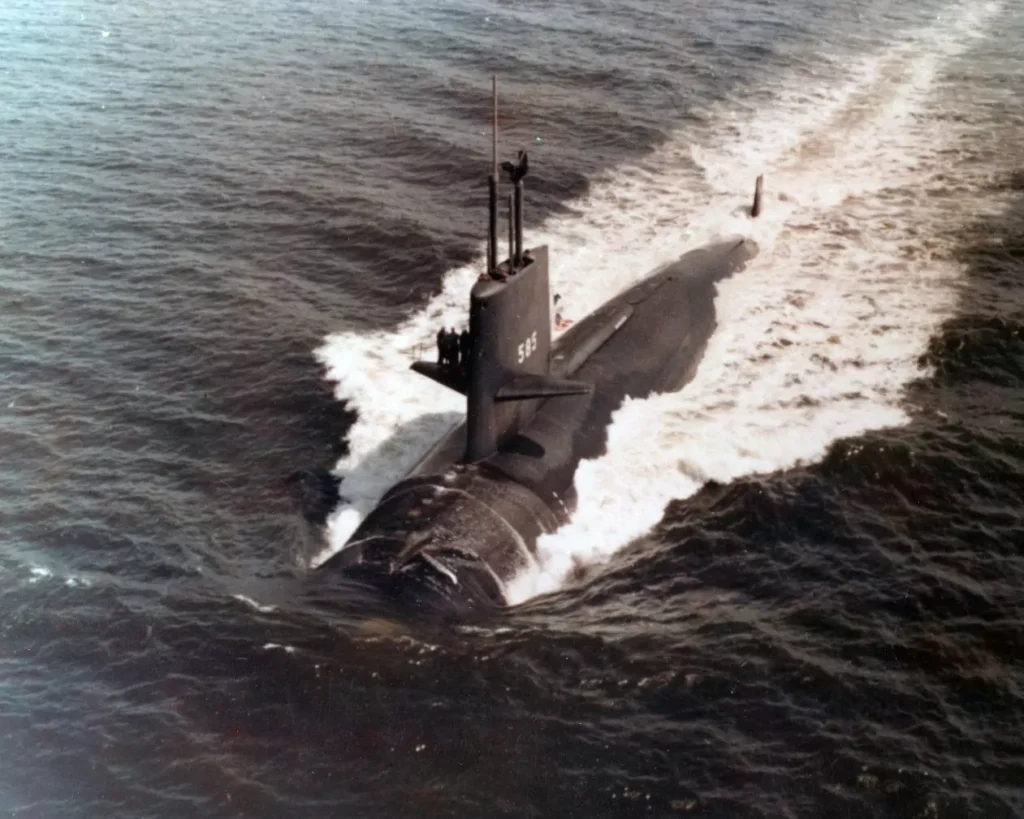
However, urgency struck with the launch of the first Soviet ICBM, the SS-6, in August 1957, stirring fears of a surprise attack on Strategic Air Command (SAC) bombers. This shifted priorities, and a planned submarine design schedule aiming for 1961/62 was deemed too slow.
To hurry production, the Navy repurposed the attack submarine Scorpion SSN 598 already under construction, and an upcoming unit as a ballistic missile submarine on the last day of 1957.
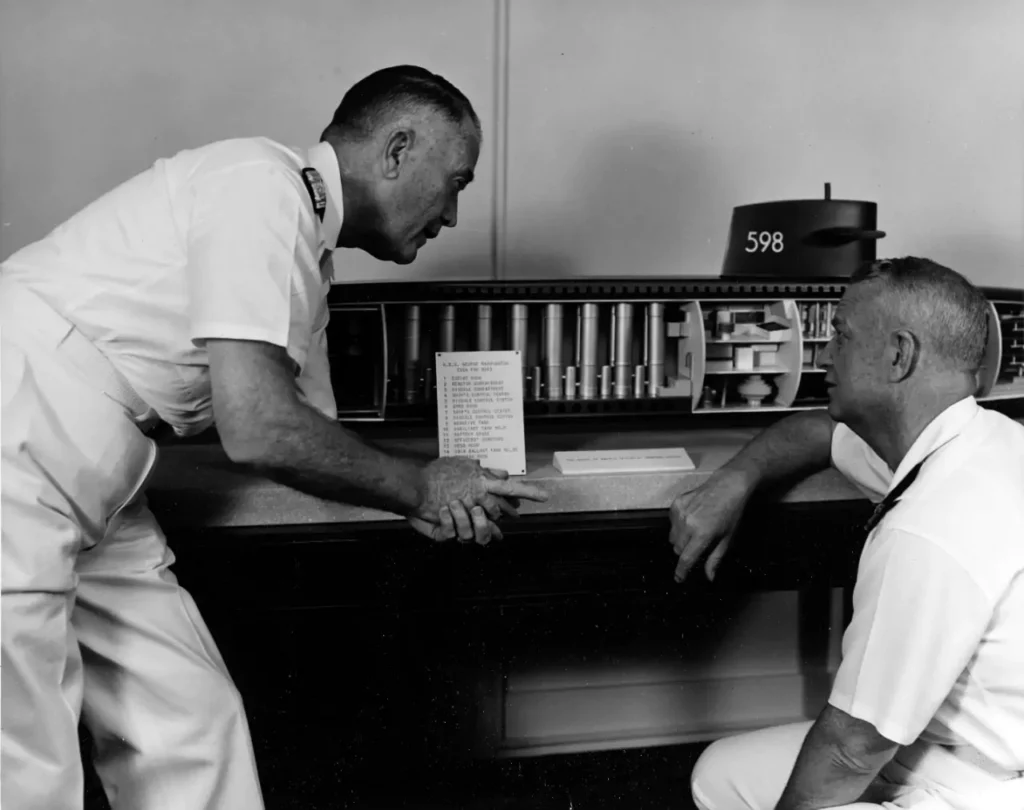
This gave rise to the first five Polaris submarines (SSBN 598–602), classified as the SCB-180A design, based on the Skipjack (SSN 585) class attack submarines. These Skipjack models showcased a streamlined hull, a singular propeller, and an S5W reactor plant capable of generating 15,000 horsepower.
The newly repurposed submarines were essentially elongated versions of the existing SSN design, stretched by 130 feet to accommodate additional navigation and missile control equipment, auxiliary machinery, and a 75-foot missile compartment (“Sherwood Forest”) housing two rows of eight Polaris missile tubes. This transformation, using components from both Scorpion and Skipjack, gave birth to the new submarine class christened George Washington.
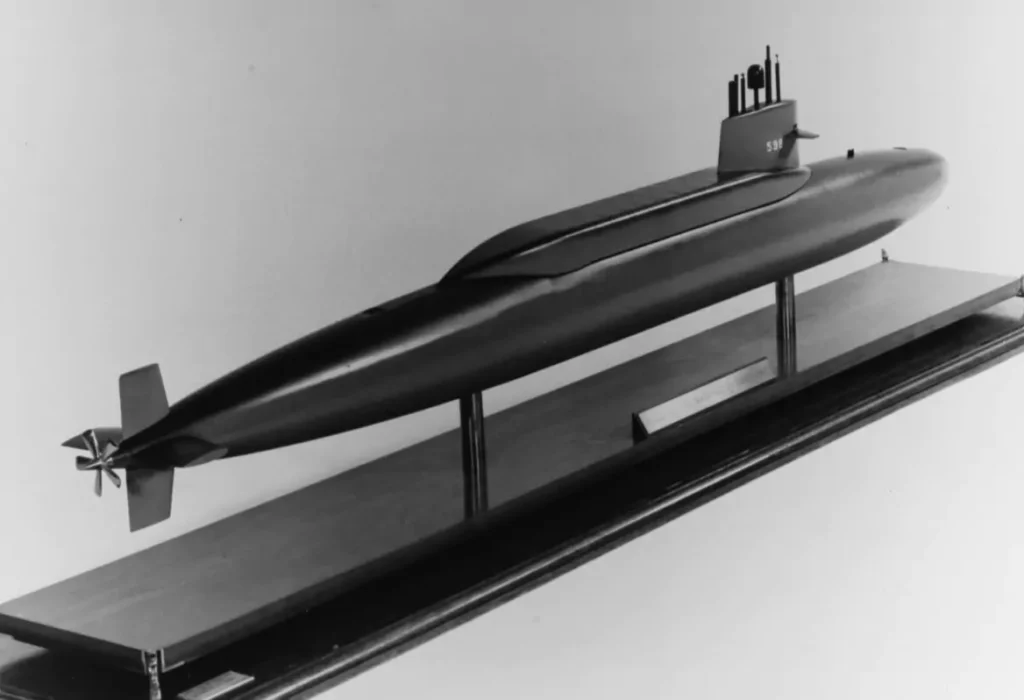
Interestingly, the USS George Washington (SSBN 598) was unique in using a missile compartment insert made of High-Tensile Steel (HTS) rather than the HY-80 steel used in the hull. This limited her test depth to about 600 feet (183 m), while the other submarines in the class—crafted with HY-80 steel in line with the Skipjack design—had a test depth of 700 feet (215 m).
In these submarines, control surfaces were expanded, a new lower rudder was extended below the keel, and the hydraulic system was augmented to handle a larger control load. The design also retained the six-tube Skipjack bow, albeit only for six reload torpedoes. Main ballast tanks were added internally to boost reserve buoyancy and ensure proper trim on the surface, alongside two large hard tanks for missile compensation.
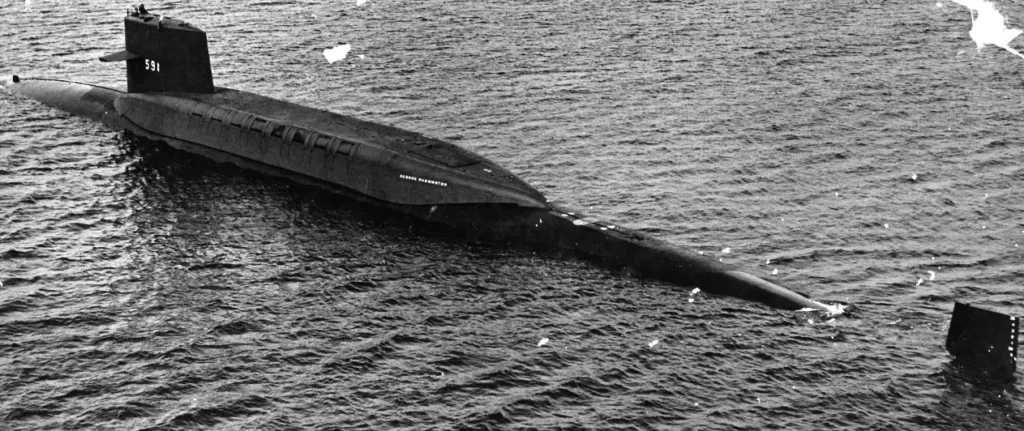
Modifications also included a widened bridge, upgraded from a four-man to a five-man setup, with accommodations for additional masts. The sail was reinforced for Arctic operations, able to resist ice damage, and equipped with two topside sonar transducers for under-ice navigation.
Behind double sea hatches, the missile tubes extended beyond the hull, leading to a raised superstructure, or “hump,” more pronounced in these submarines than in subsequent classes.
Missiles
Initially, the George Washington class submarines were equipped with Polaris A-1 missiles, having a range of 1,200 nautical miles, and were supported by Mk 80 fire control systems and compressed air missile ejectors.
During the first reactor refueling, which coincided with their overhaul, all submarines in this class were upgraded to the improved Polaris A-3 missiles, extending their range to 2,500 nautical miles. This missile refit also included an upgrade to Mk 84 fire control systems and a switch to gas-steam missile ejectors.
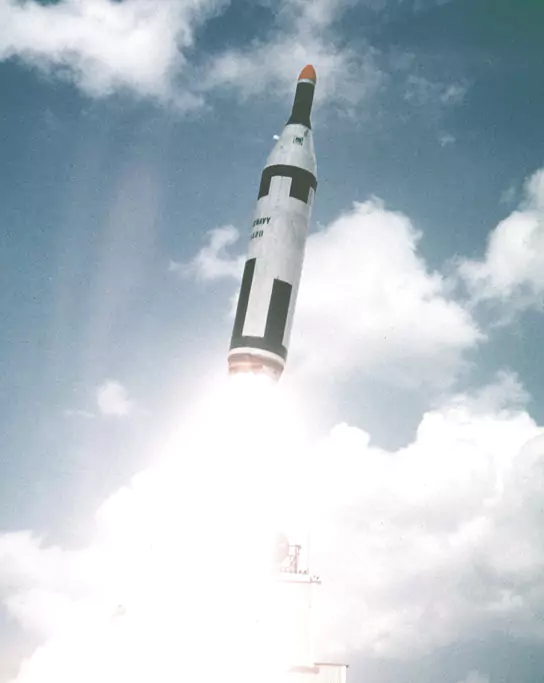
The Polaris missiles were designed to be launched from a fully submerged submarine, roughly 60 feet below the surface, at an interval of approximately one minute per missile. After receiving a launch order, it would take about 15 minutes to prepare the missiles for launch, with subsequent launches occurring at around one-minute intervals.
The submarine, while submerged, could be either stationary or moving at a maximum speed of about one knot during a launch. The depth of launch from the submarine’s keel was approximately 125 feet (38 meters).
Construction
The 1957-58 Supplemental New Construction Programme, signed on 11 Feb 1958, allocated $296 million for the creation of three nuclear-powered submarines equipped with Polaris ballistic missiles.
| No. | Name | Builder | Keel Laid | Launched | Comm. |
|---|---|---|---|---|---|
| SSBN 598 | George Washington | Electric Boat | 1 Nov 1957 | 9 Jun 1959 | 31 Dec 1959 |
| SSBN 599 | Patrick Henry | Electric Boat | 27 May 1958 | 22 Sep 1959 | 9 Jun 1960 |
| SSBN 600 | Theodore Roosevelt | Mare I NSYd | 20 May 1958 | 3 Oct 1959 | 13 Feb 1961 |
| SSBN 601 | Robert E. Lee | Newport News | 28 Aug 1958 | 18 Dec 1959 | 16 Sep 1960 |
| SSBN 602 | Abraham Lincoln | Portsmouth NSYd | 1 Nov 1958 | 14 May 1960 | 11 Mar 1961 |
The construction of these first three Fleet Ballistic Missile (FBM) submarines began in January 1958. The SS-589 was officially renamed George Washington and redesignated SSGN-598. In June 1958, these three submarines had their designations changed to SSBN, symbolizing their ballistic missile role.
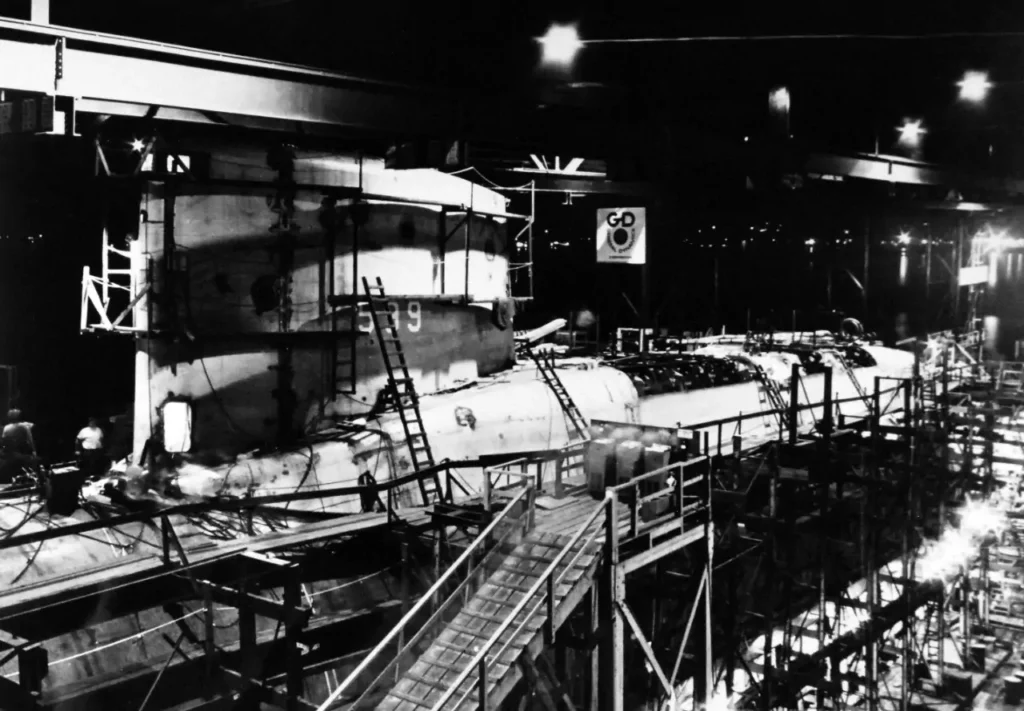
Two more such contracts were awarded in July 1958 under the Second 1957-58 Supplemental New Construction program.
The construction of these intricate submarines was a monumental task.
Take the 380-foot Patrick Henry as an example: its assembly by Electric Boat necessitated 2,669 long tons of steel, 70 miles of cable, 24 miles of pipe, 118 electric motors, and 67 tons of welding metal.
The process involved issuing over 40,000 purchase orders to various subcontractors, along with the distribution of 340,000 material requisitions to the Electric Boat Division’s storehouse for the build of the Patrick Henry.
Despite common misconceptions, these submarines were not conversions but specifically built as ballistic missile submarines. However, their construction was expedited by reassigning materials and machinery initially designated for other attack submarines. The entire class, equipped with the Polaris A-1 missile, was commissioned within a short span of 15 months.
The average cost of a 598-class Polaris submarine was about 100 million dollars each and its 16 missiles another $ 750,000 apiece. In comparison, an attack submarine did cost about $50 million so a Polaris submarine cost just about twice as much as an attack submarine.
Service
On 20 July 1960, the USS George Washington successfully launched its first Polaris A-1 missile, marking the first underwater ballistic missile launch from a US submarine.
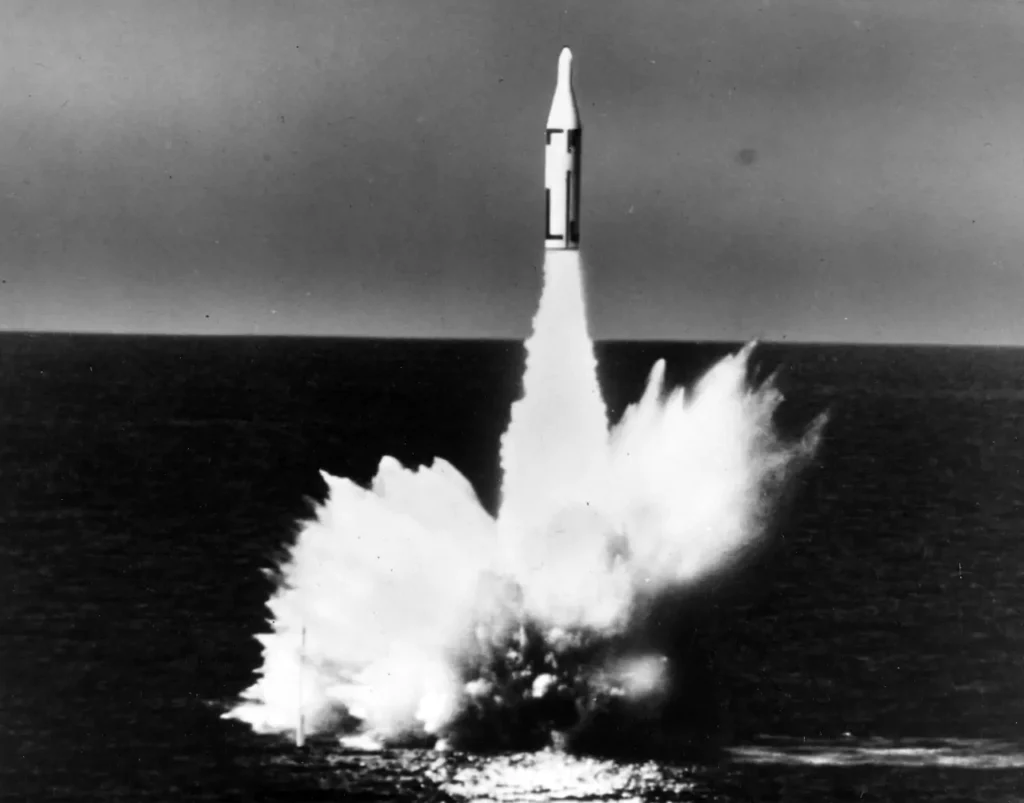
After undergoing standard sea trials and fitting out, the USS George Washington embarked on its first deterrent patrol on 15 November 1960 from Charleston Harbor, armed with sixteen Polaris A-1 ballistic missiles.
Shortly afterward, the USS Patrick Henry (SSBN-599) left Charleston on its first deterrent patrol on 30 December 1960.
![USS George Washington [left] (SSBN-598) and USS Patrick Henry Underway (SSBN-599)](https://cdn-nuclearcomp.pressidium.com/wp-content/uploads/2024/02/SSBN-598-SSBN-599-1024x812.webp)
Following a 67-day patrol, including 66 days and 10 hours submerged, the USS George Washington returned to New London, Connecticut, on 21 January 1961. At New London, it engaged in crew exchanges at the Tender USS Proteus (AS-19).
Two months after departure, the USS Patrick Henry too exchanged crews at the USS Proteus, but this time located at the newly opened base at Holy Loch, Scotland. This forward base allowed the George Washington class submarines to undergo general refurbishment and crew changes while being just a day’s sail from their North Sea launch zones.
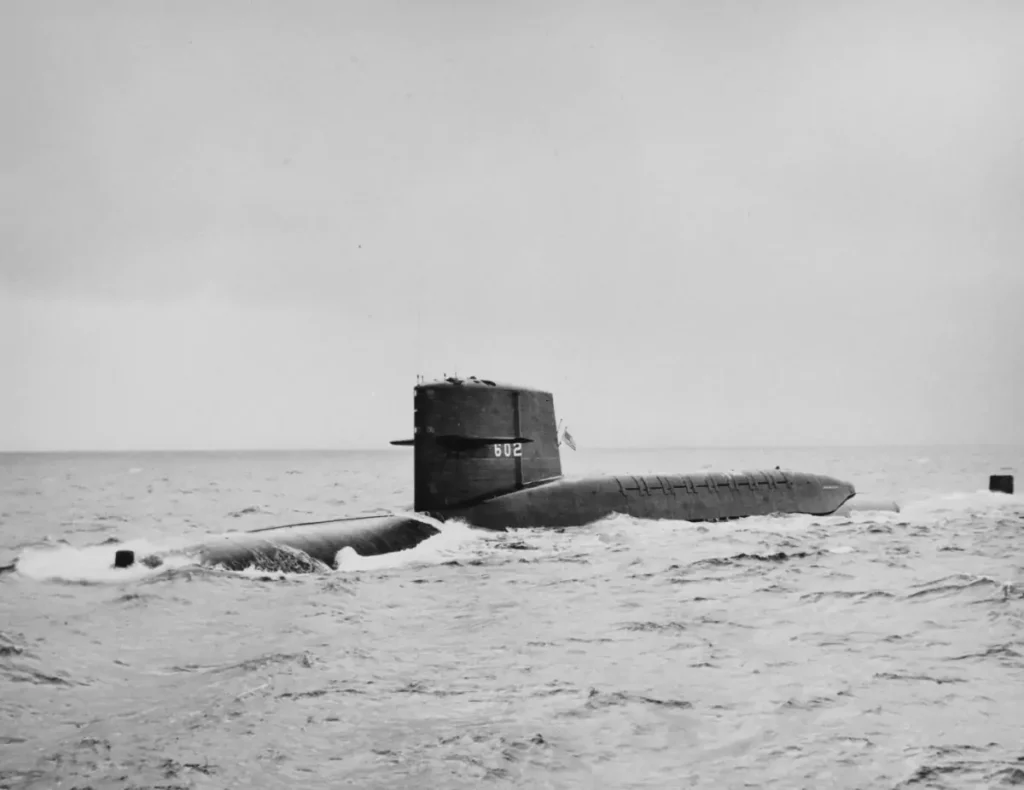
By August 1961, with the deployment of the last George Washington class submarine, USS Abraham Lincoln (SSBN-602), the Navy maintained a nearly continuous alert with a force of 80 Polaris missiles.
Missile refit and first reactor refueling
For four years, the George Washington class submarines operated with Polaris A-1 missiles. However, on June 2, 1964, the USS George Washington, the first of its class, entered the Electric Boat’s overhaul facility. This overhaul, typically undertaken every five years, involved refueling the reactor and upgrading the weapons system, replacing the Polaris A-1 with the more advanced Polaris A-3 missile.
The A-3 provided improvements in range and guidance systems, but it necessitated changes in the missile launch system due to its increased weight. The initial compressed air-launch system, which proved insufficient for ejecting the heavier A-3 missile, was replaced with a gas generation/steam method. Concurrently, the fire control systems were upgraded from Mk 80 to Mk 84.
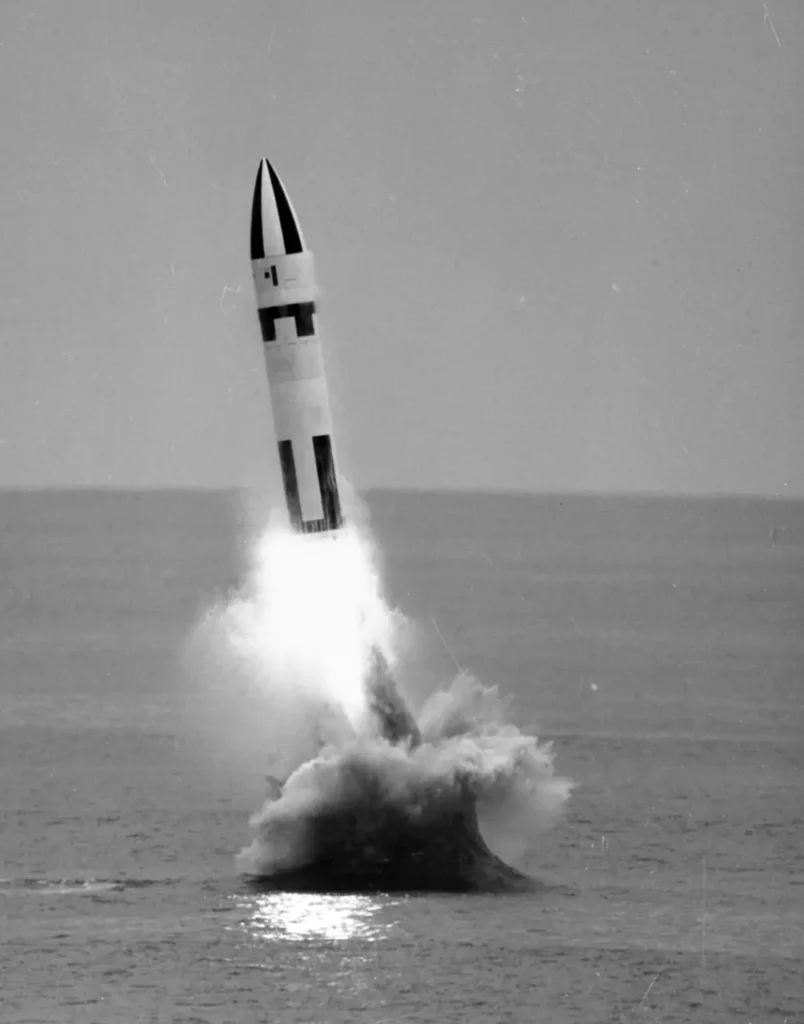
As the other George Washington class submarines underwent their respective overhauls, they too were refitted with the Polaris A-3 missile. The last Polaris A-1 patrol was completed by the USS Abraham Lincoln on October 14, 1965.
The dates of these overhauls and refits were:
- George Washington from 20 June 1964 to 2 Feb 1966
- Patrick Henry from 4 Jan 1965 to 21 July 1966
- Theodore Roosevelt from 28 July 1965 to 14 Jan 1967
- Robert E. Lee from 23 Feb 1965 to 2 July 1966
- Abraham Lincoln from 25 Oct 1965 to 3 June 1967
Robert E. Lee was overhauled at Mare Island Naval Shipyard, while the other four were done at Electric Boat Yard in Groton, Connecticut.
The USS George Washington completed its overhaul on February 2, 1966, and after subsequent inspections and shakedown, commenced its first Polaris A-3 patrol on June 30. By November 1967, all five George Washington class submarines had been re-armed with the Polaris A-3 and rejoined the Atlantic fleet.
2nd overhaul
The boats stayed at the Atlantic fleet until their second overhaul period, from June 1972 to August 1974. During this overhaul, they were equipped with the upgraded Polaris A-3T missile, which offered an enhanced range of over 3,000 miles and was capable of carrying higher-yield thermonuclear weapons with increased MIRVed warhead accuracy.
Upon completion of the overhaul, these submarines were relocated to the Pacific Fleet Ballistic Missile Force based in Guam. The transfer was concluded on August 10, 1973, with the deployment of the USS Robert E. Lee to the Pacific.
The submarines remained stationed in Guam until the entire class was retired by the Navy.
Decommission
The official withdrawal of the George Washington class submarines began on February 28, 1981, starting with the decommissioning of the USS Theodore Roosevelt and the USS Abraham Lincoln.
The missiles from these submarines were offloaded at Charleston, South Carolina, and they were deactivated at Bremerton, Washington. The missile compartments were dismantled, and the submarines were stripped of nuclear and other sensitive equipment before being scrapped.
| No. | Name | Rec. SSN | Decomm | Stricken | Broken up |
|---|---|---|---|---|---|
| SSBN 598 | George Washington | 20 Nov 1981 | 24 Jan 1985 | 30 Apr 1986 | 1998 |
| SSBN 599 | Patrick Henry | 24 Oct 1981 | 25 May 1984 | 16 Dec 1985 | 1997 |
| SSBN 600 | Theodore Roosevelt | n/a | 28 Feb 1981 | 1 Dec 1982 | 1995 |
| SSBN 601 | Robert E. Lee | 1 Mar 1982 | 1 Dec 1983 | 30 Apr 1986 | 1991 |
| SSBN 602 | Abraham Lincoln | n/a | 28 Feb 1981 | 1 Dec 1982 | 1994 |
Later in the same year, the remaining three submarines – USS George Washington, USS Robert E. Lee, and USS Patrick Henry – had their missiles removed and their tubes blocked. Temporarily, these ships served as attack submarines following the removal of all Polaris-related equipment. In addition to this, they were also utilized for special forces operations.
In 1983 and 1984, after their missile compartments and reactors were removed, the USS Robert E. Lee and the USS Patrick Henry were respectively also decommissioned. By the mid-1980s, the USS George Washington had also been retired.
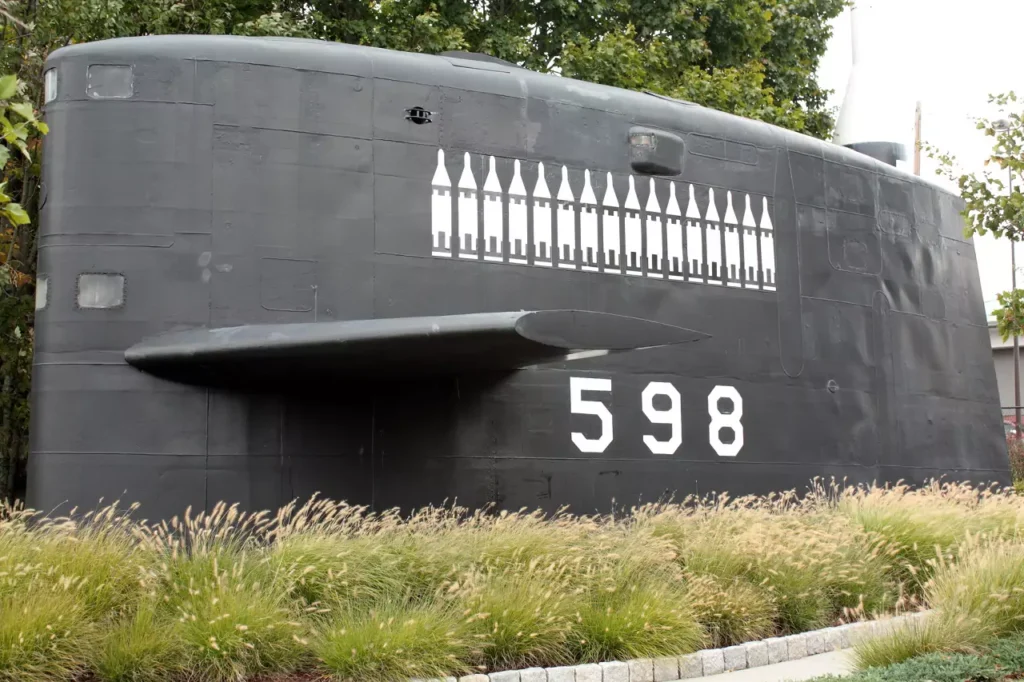
The decommissioning of these submarines was motivated by two factors: compliance with the Salt I Treaty and the fact that they had reached the end of their service life, having operated for over twenty years in conditions that subjected their hulls to saltwater corrosion and high-pressure cycles.
The names of Theodore Roosevelt, Abraham Lincoln, and George Washington were subsequently assigned to the Nimitz Class of nuclear aircraft carriers, specifically designated as CVN 71 through 73.
Further reading
Bibliography
- Polmar, N., Moore, K. J. (2014). Cold War Submarines: The Design and Construction of U.S. and Soviet Submarines. United States: Potomac Books, Incorporated.
- Polmar, N. (1993). The Naval Institute Guide to the Ships and Aircraft of the U.S. Fleet, 15th Edition. United States: Naval Institute Press.
- Gibson, J. N. (1996). Nuclear Weapons of the United States: An Illustrated History. United States: Schiffer Publishing.
- Adcock, A. (1993). U.S. Ballistic Missile Subs in Action. United States: Squadron/Signal Publications.
- Friedman, N. (1995). U.S. submarines through 1945: an illustrated design history. United States: Naval Institute Press.